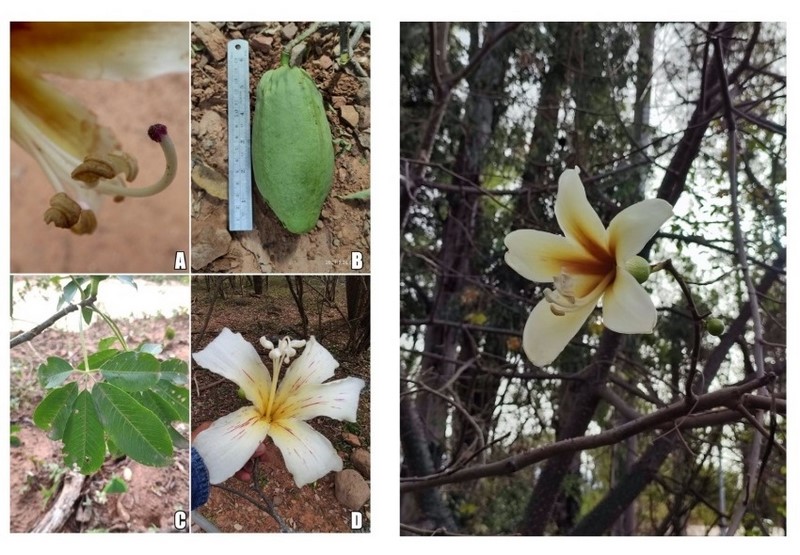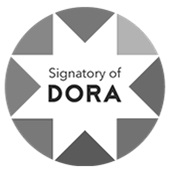Ceiba guarani (Malvaceae, Bombacoideae), una nueva especie del Subandino sur de Bolivia y las Sierras del noroeste de Argentina
DOI:
https://doi.org/10.30972/bon.3327698Palabras clave:
Bolivian-Tucuman forest, Bombacoideae, Chaco, Neotropical floraResumen
A partir de observaciones hechas durante prospecciones botánicas al Subandino sur de Bolivia, análisis de material colectado, revisión de material de herbarios y bases de datos online, determinamos que las poblaciones de Ceiba de los bosques xéricos BolivianoTucumano, previamente identificadas como Ceiba chodatii, corresponden a una nueva especie. Dado que las características morfológicas, ecológicas y de distribución difieren de lo observado en las poblaciones de C. chodatii, se propone Ceiba guarani sp. nov. Nuestras observaciones de campo y los datos de distribución de los especímenes revisados, indican que C. chodatii está naturalmente restringida a las llanuras chaqueñas, y una franja del piedemonte del Subandino sur, en tanto que Ceiba guaraní se distribuye principalmente en las serranías del Subandino.
Descargas
Citas
Bernardi, L. (1984). Contribución a la dendrología paraguaya: Bombacaceae. Boissiera 35: 30-50. https:// dx.doi.org/10.5169/seals-895487
Bionomía. (2022). Enlace especímenes de historia natural a los colectores del mundo. Karl August Gustav Fiebrig. (Accesed 4/V/2022). https://bionomia.net/Q5958231
Carvalho-Sobrinho, J. G. & de Queiroz, L. P. (2008). Ceiba rubriflora (Malvaceae: Bombacoideae), a new species from Bahia, Brazil. Kew Bulletin 63: 649-653. https://doi.org/10.1007/s12225-008-9070-6 DOI: https://doi.org/10.1007/s12225-008-9070-6
De Candolle, A. P. (1824). Bombacaceae. Prodromus systematis naturalis regni vegetabilis, pp. 475-480. Vol. 1. Sumptibus Sociorum Treuttel et Würtz, Paris.
Digilio, A. P. & Legname, P. R. (1966). Los árboles indígenas de la provincia de Tucumán. Opera Lilloana 15: 1-29.
Drawert, H. A., Angulo, A. A. & Catari, J. C. (2024). A new species of Ceiba (Malvaceae, Bombacoideae), previously confused with Ceiba speciosa. Phytotaxa 636: 207-219. https://doi.org/10.11646/ phytotaxa.636.3.1 DOI: https://doi.org/10.11646/phytotaxa.636.3.1
Fick, S. E. & Hijmans, R. J. (2017). WorldClim 2: New 1-km spatial resolution climate surfaces for global land areas. International Journal of Climatology 37: 4302-4315. https://doi.org/10.1002/joc.5086 DOI: https://doi.org/10.1002/joc.5086
Fiebrig, K. A. G. (1911). Ein Beitrag zun Pflanzengeographie Boliviens. Pflanzengeographische Skizze auf Grund einer Forschungsreise mi andinen Süden Boliviens. Botanische Jahrbücher Für Systematik, Pflanzengeschichte Und Pflanzengeographie 45: 1-68. https://www.biodiversitylibrary.org/item/707
Gibbs, P. & Semir, J. (2003). A taxonomic revision of the genus Ceiba Mill. (Bombacaceae). Anales Del Jardín Botánico de Madrid 60: 59-300. https://doi.org/10.3989/ajbm.2002.v60.i2.92 DOI: https://doi.org/10.3989/ajbm.2002.v60.i2.92
Gibbs, P., Semir, J. & Da Cruz, N. (1988). Proposal to unite the genera Chorisia Kunth and Ceiba Miller (Bombacaceae). Notes from the Royal Botanic Garden, Edinburgh 45: 125-136.
HVAA. (2022). Herbario Virtual Austral Americano. Herbario Virtual Austral Americano. (Accesed 1/5/2022). https://herbariovaa.org
iNaturalist. (2022). iNaturalist Database. (Accesed 11/6/2022). https://www.inaturalist.org
Jussieu, A. L. (1789). Genera Plantorum. Apud viduam Herissant et Theophilum Barrois, Paris.
Kunth, C. (1822). Chorisia. En Humboldt F., Bonpland, A. & C. Kunth (eds.), Nova genera el species plantarum, vol. 5, pp. 295-298. Antverpiae, ex officina Christophori Plantini, Paris.
López, R. P. (2003). Diversidad florística y endemismo de los valles secos bolivianos. Ecología en Bolivia 38: 27- 60.
http://www.scielo.org.bo/scielo.php?pid=S1605-25282003000100004&script=sci_arttext
Lozano, E. C. & Zapater, M. A. (2018). Delimitación taxonómica de Ceiba chodatii y C. speciosa (Malvaceae, Bombacoideae) en diferentes estadios fenológicos. Boletín de la Sociedad Argentina de Botánica 53: 295-306. https://doi. org/10.31055/1851.2372.v53.n2.20585 DOI: https://doi.org/10.31055/1851.2372.v53.n2.20585
Martín, C. M., Zanotti, C. A., Acuña-Castillo, R., Henning, T., Catari, J. C. & Weigend, M. (2022). Taxonomic revision of the peculiar genus Xylopodia (Loasaceae) with a new species from Argentina and Bolivia demonstrating an atypical trans-Andean disjunction. PhytoKeys 194: 47-62. https://doi. org/10.3897/phytokeys.194.77827 DOI: https://doi.org/10.3897/phytokeys.194.77827
Martius, K. F. P. (1886). Flora brasiliensis (vol. 12, pars. 3). Monachii et Lipsiae, Munich & Leipzig. https://doi.org/10.5962/bhl.title.454 DOI: https://doi.org/10.5962/bhl.title.454
Melgar, D., Gutiérrez, G., Araujo-Murakami, A. & Álvarez, C. (2021). El género Ceiba (Malvaceae) en Bolivia. Revista de la Sociedad Boliviana de Botánica 12: 5-29.
Miller, P. (1754). Gardeners dictionary, 4th ed., Vol. 1. John & James Rivington Brothers, London. https:// doi.org/10.5962/bhl.title.79061
Naturalis Biodiversity Center. (2022). BioPortal. Specimen | Ceiba insignis (Kunth) P. E. Gibbs & Semir | U.1380811 | BioPortal. (Accessed 4 May 2022). https://bioportal.naturalis.nl/specimen/U.1380811
Navarro, G. (2002). Provincia Biogeográfica Boliviano Tucumana. En Navarro G. & M. Maldonado (eds.), Geografía Ecológica de Bolivia: Vegetación y Ambientes Acuáticos, pp. 351-428. Centro de Ecología Simón I, Patiño, Santa Cruz de la Sierra.
Navarro, G. & Ferreira, W. (2009). Biogeografía de Bolivia. En Moraes M., Mostacedo, M., Zapata, B. & S. Altamirano (eds.), Libro Rojo de parientes silvestres de cultivos de Bolivia. Ministerio de Medio ambiente y Agua -Vice ministerio de Medio Ambiente, Biodiversidad y Cambio Climático, PLURAL Editores, La Paz.
Perrotta, V. G., Stenglein, S. A. & Arambarri, A. M. (2007). Leaf anatomy of Ceiba chodatii and C. speciosa (Bombacaceae). Kurtziana 33: 17-25.
Pezzini, F. F., Dexter, K. G., De Carvalho-Sobrinho, J. G., Kidner, C. A., Nicholls, J. A., De Queiroz, L. P. & Pennington, R. T. (2021). Phylogeny and biogeography of Ceiba Mill. (Malvaceae, Bombacoideae). Frontiers of Biogeography 13: e49226. https://doi.org/10.21425/F5FBG49226 DOI: https://doi.org/10.21425/F5FBG49226
Ravenna, P. (1998). On the identity, validity and actual placement in Ceiba of several Chorisia species (Bombacaceae) and description of two new South American species. Onira 3: 42-51.
Schumann, C. (1886). Bombacaceae. En Martius K. F. P. von & A. W. Eichler (eds.), Flora Brasiliensis vol. 12, pp. 201-250. Frid. Fleischer in Comm., Munich & Leipzig. https://www.biodiversitylibrary. org/item/9640
SENAMHI. (2022). Servicio Nacional de Meteorología e Hidrología [Database]. Información Nacional de Datos Hidrometeorológicos. (Accessed 21/6/2022). http://senamhi.gob.bo/index.php/sysparametros

Descargas
Publicado
Cómo citar
Número
Sección
Licencia
Derechos de autor 2024 Bonplandia

Esta obra está bajo una licencia internacional Creative Commons Atribución 4.0.
Declaration of Adhesion to Open Access
- All contents of Bonplandia journal are available online, open to all and for free, before they are printed.
Copyright Notice
- Bonplandia magazine allows authors to retain their copyright without restrictions.
- The journal is under a Creative Commons Attribution 4.0 International license.














.jpg)


